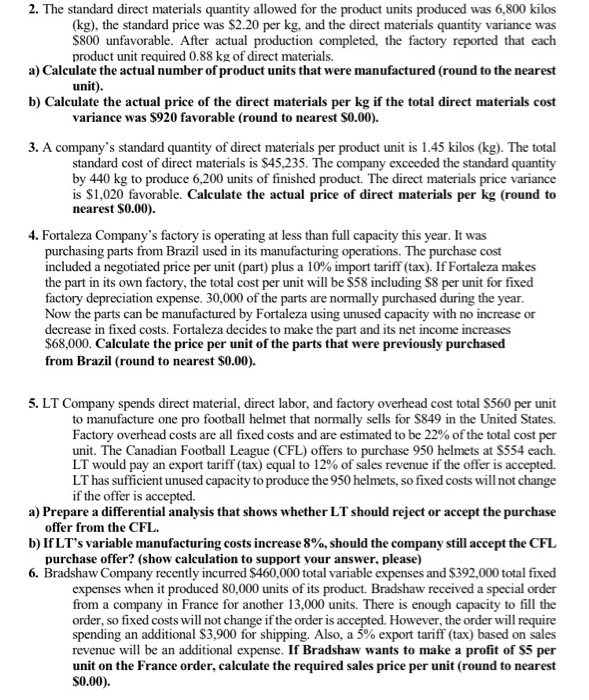
More Questions=More Rates!!!
2. The standard direct materials quantity allowed for the product units produced was 6,800 kilos (kg), the standard price was $2.20 per kg, and the direct materials quantity variance was $800 unfavorable. After actual production completed, the factory reported that each product unit required 0.88 kg of direct materials. a) Calculate the actual number of product units that were manufactured (round to the nearest unit). b) Calculate the actual price of the direct materials per kg if the total direct materials cost variance was $920 favorable (round to nearest $0.00). 3. A company's standard quantity of direct materials per product unit is 1.45 kilos (kg). The total standard cost of direct materials is $45,235. The company exceeded the standard quantity by 440 kg to produce 6,200 units of finished product. The direct materials price variance is $1,020 favorable. Calculate the actual price of direct materials per kg (round to nearest $0.00). 4. Fortaleza Company's factory is operating at less than full capacity this year. It was purchasing parts from Brazil used in its manufacturing operations. The purchase cost included a negotiated price per unit (part) plus a 10% import tariff (tax). If Fortaleza makes the part in its own factory, the total cost per unit will be $58 including S8 per unit for fixed factory depreciation expense. 30,000 of the parts are normally purchased during the year. Now the parts can be manufactured by Fortaleza using unused capacity with no increase or decrease in fixed costs. Fortaleza decides to make the part and its net income increases $68,000. Calculate the price per unit of the parts that were previously purchased from Brazil (round to nearest $0.00). 5.LT Company spends direct material, direct labor, and factory overhead cost total $560 per unit to manufacture one pro football helmet that normally sells for $849 in the United States. Factory overhead costs are all fixed costs and are estimated to be 22% of the total cost per unit. The Canadian Football League (CFL) offers to purchase 950 helmets at $554 each. LT would pay an export tariff (tax) equal to 12% of sales revenue if the offer is accepted. LT has sufficient unused capacity to produce the 950 helmets, so fixed costs will not change if the offer is accepted. a) Prepare a differential analysis that shows whether LT should reject or accept the purchase offer from the CFL. b) If LT's variable manufacturing costs increase 8%, should the company still accept the CFL purchase offer? (show calculation to support your answer, please) 6. Bradshaw Company recently incurred $460,000 total variable expenses and $392,000 total fixed expenses when it produced 80,000 units of its product. Bradshaw received a special order from a company in France for another 13,000 units. There is enough capacity to fill the order, so fixed costs will not change if the order is accepted. However, the order will require spending an additional $3,900 for shipping. Also, a 5% export tariff (tax) based on sales revenue will be an additional expense. If Bradshaw wants to make a profit of $5 per unit on the France order, calculate the required sales price per unit (round to nearest $0.00)
 More Questions=More Rates!!!
More Questions=More Rates!!!





